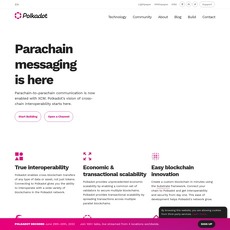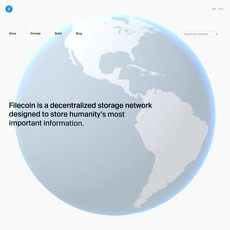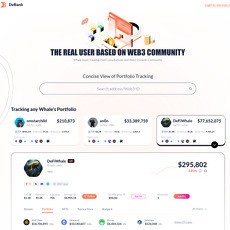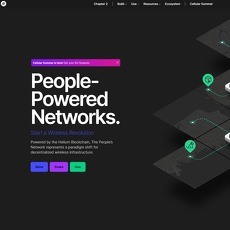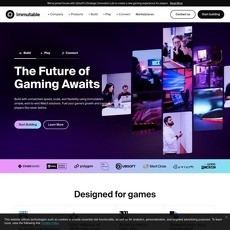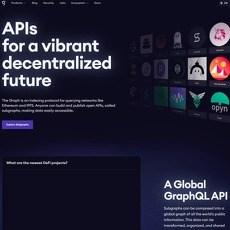Web 3.0 Crypto Projects and Web3 Sites
Exploring the Top Web 3.0 Crypto Projects: A Comprehensive Web3 Review
Ever feel like the internet is changing faster than you can keep up? Wondering how this evolution impacts the cryptocurrencies you're interested in? You're not alone. Many of us are trying to make sense of what's next, and I'm here to help you navigate this thrilling frontier.
The world of Web 3.0 is buzzing with innovation, and new crypto projects are popping up that could redefine how we interact online. These aren't just buzzwords—they have the potential to change our digital lives fundamentally. So, let's explore these pioneering projects together and see what they have to offer.
The Challenge: Navigating the Web 3.0 Landscape
The Web 3.0 space is vast and constantly evolving. With so many new projects and technologies emerging, it's easy to feel overwhelmed. How do you know where to start or which projects are worth your attention?
Finding the Right Information
Have you ever tried searching for information on Web 3.0, only to end up more confused than when you started? It's a hassle sifting through countless articles and forums, trying to make sense of technical jargon and hype.
- You might find articles that are either too technical or overly simplistic.
- Forums can offer insights but often have conflicting opinions.
- Official project websites sometimes lack clear explanations for newcomers.
All this makes it tough to get a clear picture of what's actually happening in the Web 3.0 space.
Keeping Up with Rapid Changes
The crypto universe moves at lightning speed. New developments appear overnight, and staying updated feels like a full-time job. According to a recent study by Blockchain.com Research, there were over 10,000 active cryptocurrencies as of 2023, a number that's steadily increasing.
With so much happening, it's challenging to keep track of the projects that matter most.
Feeling Confident in Your Choices
Making informed decisions in this fast-paced environment isn't easy. You might feel unsure about which projects are legitimate and have real potential. After all, nobody wants to invest time or money into something that doesn't deliver.
Here are some common concerns:
- Trustworthiness: Can I trust the team behind this project?
- Value Proposition: Does this project solve a real problem?
- Community Support: Is there an active and supportive community?
These are valid questions, and finding reliable answers is crucial.
But don't worry—I'm here to help make sense of it all. Ready to discover how Web 3.0 crypto projects could benefit you and transform the way we interact online? Let's jump in!
What Is Web 3.0 and Why It Matters
Have you ever felt like the internet has become a bit... impersonal? I know I have. It seems like the big corporations hold all the cards, and we're just along for the ride. But what if I told you that the internet is evolving into something that puts us back in control? That's where Web 3.0 comes in.
"The future is already here—it's just not evenly distributed." – William Gibson
This quote hits home when we talk about Web 3.0. It's the next generation of the internet that's starting to take shape, and it's all about decentralization, privacy, and giving power back to the users—you and me.
The Evolution from Web 1.0 to Web 3.0
Let's take a trip down memory lane. Remember the early days of the internet? Web 1.0 was like a giant library filled with static pages. We could read information, but interaction was minimal. Then came Web 2.0, introducing interactive content, social media, and user-generated content. Suddenly, we weren't just consuming the internet—we were contributing to it.
Now, Web 3.0 is taking things a step further. It's not just about interacting with content; it's about owning it. Imagine an internet where you have control over your data, and the platforms you use are decentralized. That's the promise of Web 3.0—a user-owned internet.
Key Features of Web 3.0
So, what's so special about Web 3.0? Here are some key features that set it apart:
- Decentralization: No more central authorities controlling everything. Instead, networks are distributed across many computers.
- Blockchain Technology: The backbone of Web 3.0, providing security and transparency through immutable ledgers.
- Smart Contracts: Self-executing contracts with the terms directly written into code, removing the need for intermediaries.
- Decentralized Applications (dApps): Apps that run on a blockchain network rather than a single server, ensuring they're always up and can't be censored.
- Enhanced Privacy: You're in control of your data, deciding what to share and with whom.
These features combine to create an online environment that's more secure, transparent, and empowering for users.
The Role of Cryptocurrency
You might be wondering, "Where do cryptocurrencies fit into all this?" Well, they're the fuel that powers Web 3.0. Cryptocurrencies enable decentralized transactions without the need for banks or intermediaries. They also incentivize people to participate in the network. For example:
- Transaction Facilitation: Cryptos allow for seamless peer-to-peer transactions across the globe.
- Network Incentives: Users can earn tokens by contributing to the network, whether by providing computing power, data storage, or other services.
- Governance: Token holders often have a say in the future development of a project, making the platforms truly user-driven.
In essence, cryptocurrencies are the lifeblood of Web 3.0, making decentralized networks possible and practical.
Feeling excited about what Web 3.0 could mean for you? We're just scratching the surface here. There's so much more to explore, especially the projects that are turning this vision into reality. Want to know which Web 3.0 crypto projects are leading the charge? Let's check them out next!
Top Web 3.0 Crypto Projects to Watch
As we step into this new internet era, certain crypto projects are emerging as game-changers. I've been following some of these innovators closely, and I'm excited to share them with you. Let's take a look at the top Web 3.0 crypto projects that are shaping our digital future.
Polkadot (DOT)
First on the list is Polkadot, represented by the DOT token. Imagine different blockchains speaking different languages—Polkadot acts like a translator, enabling them to interact seamlessly. This connectivity fosters a more united and efficient ecosystem. For example, a decentralized app on one blockchain can communicate and share information with another, thanks to Polkadot's network. It's all about breaking down barriers and creating a more interconnected digital world.
Chainlink (LINK)
Next up is Chainlink with its LINK token. One of the biggest challenges in blockchain technology is bringing real-world data onto the blockchain in a reliable way. Chainlink solves this by providing secure oracles that supply external data to smart contracts. Think about it like this: if a smart contract needs to know the current temperature for an insurance payout, Chainlink delivers that data accurately. This opens up endless possibilities for decentralized applications to interact with real-world events.
Filecoin (FIL)
Filecoin and its token FIL are revolutionizing data storage. Instead of relying on traditional centralized servers, Filecoin offers a decentralized storage network. Users can rent out their unused hard drive space, creating a massive, global storage system that's more secure and efficient. This means your data isn't stored in one vulnerable spot but distributed across many nodes, enhancing security and resilience. It's a significant step toward giving control back to users over their own data.
Other Noteworthy Projects
There are other exciting projects making their mark as well:
- Cosmos (ATOM): Aims to build the "Internet of Blockchains," allowing diverse blockchains to communicate and transact with each other. This interoperability is crucial for a cohesive blockchain ecosystem.
- Decentraland (MANA): Creates a virtual reality platform where users can buy, develop, and sell virtual land. It's not just a game; it's a new way to experience and monetize digital content and applications.
"The future belongs to those who believe in the beauty of their dreams." – Eleanor Roosevelt
These projects aren't just technical innovations—they're bold visions turning into reality. They represent our collective dream for a more decentralized, user-focused internet.
But what makes these cryptocurrencies truly stand out in the market, and how can they add value to your life? There's so much more to explore, so let's keep this journey going!
Exploring the Best Web 3.0 Cryptocurrencies
As I delve deeper into the world of Web 3.0, I've discovered some cryptocurrencies that truly make a mark. These aren't just digital coins; they're the lifeblood of networks aiming to transform how we interact online. Let's take a closer look at what makes these cryptocurrencies so special.
Understanding Their Value
The real value of Web 3.0 tokens goes beyond their market price. Take Ethereum (ETH), for example. It's not just another cryptocurrency; it's a platform that enables developers to build decentralized applications (dApps). This means real-world solutions for finance, gaming, and even social media are being powered by Ethereum.
Then there's Chainlink (LINK), which connects smart contracts with real-world data. Imagine a crop insurance contract that automatically pays out if certain weather conditions are met. Chainlink makes this possible by providing reliable data to the blockchain.
These tokens empower networks that are solving genuine problems, making our digital experiences more secure, transparent, and user-centric.
Market Performance
The growth of these cryptocurrencies speaks volumes about their potential. For instance, Polkadot (DOT) has seen significant adoption because it allows different blockchains to communicate. This interoperability is a game-changer, and the market recognizes that.
According to Blockchain.com, Web 3.0 tokens have experienced a surge in user adoption over the past year. This isn't just hype; it's a reflection of the growing trust and reliance on these networks.
Investors are not just looking at current performance but at the underlying technology and its potential to disrupt existing systems.
Choosing the Right One for You
Picking the right cryptocurrency can feel like finding a needle in a haystack. Here's what I consider when making my decision:
- Project's Purpose: Does it address a real need? For example, Filecoin (FIL) provides decentralized storage solutions, offering a secure way to store data.
- The Team Behind It: A strong, experienced team can make all the difference. Research their background and previous projects.
- Community Support: An active community often reflects a project's health and future prospects. Engage with forums and social channels to gauge this.
It's essential to align your choices with your interests and values. After all, investing in a cryptocurrency is also about supporting a vision for the future.
"The best way to predict the future is to create it." - Peter Drucker
This quote resonates with me because by choosing the right projects, we're not just observers—we're participants in shaping what's to come.
Feeling excited about the possibilities? I know I am. But you might be wondering, how do these projects sustain themselves financially? In the next section, we'll explore how Web 3.0 projects generate revenue and what that means for us as users. Trust me, you won't want to miss it!
How Web3 Projects Generate Revenue
You might be wondering, "How do these Web3 projects keep the lights on?" It's a great question, and understanding the revenue models behind these projects can give us deeper insight into their sustainability and potential. Let's take a look at the ways Web3 projects are making money in this new digital economy.
Transaction Fees and Tokens
One of the primary ways Web3 projects generate revenue is through transaction fees. Whenever you make a transaction on a blockchain network, there's often a small fee attached. These fees, sometimes called "gas fees," are paid in the network's native token and help support the infrastructure.
For example, Ethereum charges fees in Ether (ETH) for transactions, which incentivizes miners or validators to process and secure the network. This model not only supports the project's operations but also encourages a healthy ecosystem where participants are rewarded for their contributions.
NFTs and Digital Assets
The explosion of Non-Fungible Tokens (NFTs) has opened up new revenue streams for Web3 projects. By creating and selling unique digital assets, projects can generate income while offering users something of value. It's not just about art and collectibles; NFTs are being used in gaming, music, and even real estate to represent ownership of digital and physical assets.
Consider platforms like OpenSea or Axie Infinity, where NFTs are bought and sold, often with a percentage of each sale going back to the project. This creates a self-sustaining model that benefits both the creators and the community.
Staking and Participation Rewards
Another innovative revenue model is staking. By allowing users to "stake" or lock up their tokens, projects can secure their networks while offering rewards. It's a win-win situation: the network gains stability, and users earn passive income.
- Projects like Polkadot allow staking of DOT tokens for network governance and security.
- Participants receive rewards, often in the form of additional tokens.
- This incentivizes long-term involvement and fosters a committed community.
"The best way to predict the future is to create it." – Peter Drucker
This quote resonates with the Web3 movement. By actively participating, we're not just observing the future of the internet—we're building it together.
Understanding these revenue models is key to appreciating how Web3 projects are not just tech experiments but viable businesses. And as we continue to explore this space, you might be curious about how all of this impacts the future of the internet itself.
So, what's next on the horizon for Web3, and how will it shape our online experiences? Let's continue our journey and find out.
The Impact of Web 3.0 on the Future of the Internet
I've always felt that we're standing on the brink of a new era in the digital world. Web 3.0 isn't just a buzzword—it's a seismic shift that's set to redefine how we interact online. Picture an internet where you have genuine ownership of your data, where transparency is the norm, and where innovation isn't stifled by gatekeepers. That's the future Web 3.0 is crafting for us.
Empowering Users
At the heart of Web 3.0 is the empowerment of users like you and me. Gone are the days when our personal information was controlled and monetized by giant corporations. With decentralization, we hold the keys to our data. You decide who accesses your information and how it's used. It's about reclaiming control and fostering a sense of digital independence.
"The future of the internet is one where the users are in charge, not as products, but as empowered participants."
Driving Innovation
The innovations emerging from this new wave are nothing short of revolutionary. In finance, decentralized platforms are creating financial services that are accessible to everyone, not just the privileged few. Gaming is becoming more immersive, with players owning in-game assets that have real-world value. Social networks are transforming into spaces that prioritize community and authenticity over algorithms and ads.
- Finance: DeFi platforms offering open access to financial tools.
- Gaming: True ownership of digital assets through NFTs.
- Social Media: Community-driven platforms promoting genuine connections.
These aren't just theoretical ideas—they're real projects reshaping industries as we speak.
Overcoming Challenges
But let's be honest, every innovation comes with its challenges. User experience can sometimes feel daunting, especially if you're new to the space. Scalability issues can make transactions slow or expensive during peak times. Yet, the beauty of the Web 3.0 community is its relentless drive to improve. Developers are actively working on solutions like layer-2 scaling and more intuitive interfaces to make the experience smoother for everyone.
It's an exciting time, with each obstacle presenting an opportunity for growth and collaboration. And trust me, the progress we're seeing is just the beginning.
Curious about how you can be a part of this transformative journey? Wondering where to start or how to get involved with these trailblazing projects? In the next part, I'll share some practical steps to dive into the world of Web 3.0 and make your own impact.
How to Get Involved with Web 3.0 Projects
Feeling inspired by the possibilities of Web 3.0? I'm excited to share how you can jump in and become part of this groundbreaking movement. It's not just for tech experts; there's room for everyone to participate and benefit.
Investing in Cryptocurrencies
One of the most straightforward ways to get involved is by investing in Web 3.0 cryptocurrencies. Platforms like Binance and Coinbase make it easy to purchase tokens like DOT, LINK, or FIL. By holding these tokens, you're not only investing in potential financial growth but also supporting the projects that are shaping the future of the internet. In fact, many of these tokens have seen significant appreciation as more people recognize the potential of Web 3.0 technologies.
Using Decentralized Applications
Experiencing Web 3.0 firsthand is as simple as trying out some decentralized applications (dApps). Whether it's exploring virtual worlds in Decentraland or using decentralized finance platforms like Uniswap, these applications offer a glimpse into the future of online interaction. Did you know that, according to recent reports, the number of active dApp users has been steadily increasing, signaling a growing interest in decentralized services?
Joining Communities
Being part of the community is at the heart of Web 3.0. You can join forums like r/CryptoCurrency on Reddit, participate in Telegram groups, or attend webinars hosted by project teams. Engaging with others not only keeps you informed but also connects you with like-minded enthusiasts who are just as passionate as you are.
As the saying goes,
"Alone we can do so little; together we can do so much." - Helen Keller
By joining forces with the Web 3.0 community, we're not just observers—we're contributors to a paradigm shift in how we use the internet.
But what's the next step to ensure we're making the most of this opportunity? In the upcoming section, we'll look into the potential risks and considerations you should be aware of to navigate this space confidently.
Potential Risks and Considerations
Before jumping into the Web 3.0 world, it's crucial to understand the potential risks involved. I want to make sure you're well-prepared as you explore these exciting projects.
Market Volatility
The cryptocurrency market can be unpredictable. Prices can skyrocket one day and take a steep turn the next. For instance, we've seen coins like Ethereum experience significant swings within short periods. It's important to invest wisely and only put in what you're comfortable potentially losing. Keeping a balanced portfolio and staying informed can help you navigate these ups and downs.
Security Concerns
With the rise of Web 3.0 projects, unfortunately, comes an increase in scams and hacks. Remember hearing about phishing attacks where users unknowingly give away their private keys? Or smart contract bugs that lead to lost funds? To protect yourself, always use reputable platforms, double-check URLs, enable two-factor authentication, and never share your private information. Staying vigilant can go a long way in keeping your assets safe.
Regulatory Changes
The legal landscape around cryptocurrencies is constantly evolving. Governments worldwide are still figuring out how to regulate this new space. Changes in laws could impact how you access or use certain projects. For example, some countries have introduced strict regulations on crypto exchanges, affecting how people trade or hold digital assets. Keeping an eye on regulatory developments ensures you're not caught off guard.
Being aware of these risks doesn't mean you should shy away from Web 3.0—it just means you're getting smarter about how you engage with it. Wondering what the future holds and how you can make the most of it? Let's keep exploring together.
Looking Ahead: The Future of Web 3.0
As we stand on the cusp of a new era for the internet, it's exciting to think about where Web 3.0 will take us next. The landscape is rapidly evolving, and with it comes a host of emerging trends that could redefine how we interact with the digital world.
Emerging Trends to Watch
One of the most thrilling aspects of Web 3.0 is the constant stream of new technologies and ideas. Here are some trends that I believe are worth keeping an eye on:
- Decentralized Finance (DeFi) Expansion: DeFi has already made significant waves by providing decentralized alternatives to traditional financial services. Platforms like Aave and Uniswap are spearheading this movement. According to a report by Statista, the total value locked in DeFi services reached over $100 billion in 2023, showcasing its rapid growth.
- Interoperability Between Blockchains: Projects focusing on connecting different blockchains are gaining momentum. For instance, Cosmos aims to create an "internet of blockchains," allowing for seamless communication and transactions across networks.
- Non-Fungible Tokens (NFTs) Revolutionizing Ownership: NFTs have exploded in popularity, changing how we perceive digital ownership. From art to music and virtual real estate, NFTs are opening new avenues for creators and collectors alike.
- Metaverse Development: The concept of a fully immersive digital world is becoming more tangible. Platforms like Decentraland and The Sandbox are building virtual spaces where users can interact, play, and even conduct business.
- Enhanced Privacy Solutions: With growing concerns over data privacy, there's a push towards technologies that offer greater anonymity and security. Projects like Zero-Knowledge Proofs are at the forefront of this movement.
These trends are just the tip of the iceberg. The continuous innovation in Web 3.0 promises to bring even more groundbreaking developments that could alter our digital experiences significantly.
Your Role in the Web 3.0 Movement
You might be wondering how you can be part of this exciting journey. The good news is, there's plenty of room for everyone to contribute and benefit from Web 3.0. Here's how you can get involved:
- Educate Yourself: Stay informed about the latest developments. Follow blogs, join forums, and participate in webinars to deepen your understanding.
- Engage with Communities: Joining communities on platforms like Discord or Reddit can connect you with like-minded individuals and provide valuable insights.
- Support Projects You Believe In: Whether by investing, using their services, or spreading the word, your support can make a difference for emerging projects.
- Contribute Your Skills: If you have expertise in programming, design, marketing, or other areas, consider contributing to open-source projects or startups in the Web 3.0 space.
- Advocate for Decentralization: Share the principles of Web 3.0 with others. Encouraging a broader understanding can help drive adoption and innovation.
Your participation isn't just about personal gain; it's about shaping the future of the internet into a space that's more fair, secure, and accessible for everyone.
Final Thoughts
As I reflect on the incredible journey through the world of Web 3.0 crypto projects, I'm filled with optimism. The innovations we've discussed are more than just technological advancements; they're steps towards a more decentralized and empowering digital landscape.
I hope this exploration has ignited your curiosity and inspired you to take a closer look at what Web 3.0 has to offer. Remember, this is a collective movement, and your involvement matters. Together, we can help shape an internet that truly serves its users.
The future is bright, and we're just getting started. So, let's embrace the possibilities that Web 3.0 brings and look forward to the exciting developments that await us.

